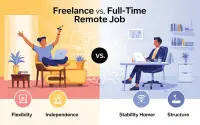Why REMOTE Jobs Is the Future
Hybrid Work Models
Hybrid work models blending remote and in-person work are becoming the norm for 2024/2025. in 2023, 60% of workers desire remote work most of the time, while 50% of leaders support hybrid setups. This trend shows no signs of slowing down, and now many companies are hiring for fully Remote position locally as well as globally means work from home no commuting required, isn’t it cool? Yes it is
Hybrid models stems from changing work expectations. Over 50% of leaders now favor split-week arrangements, mixing office and home workdays. This approach aligns company needs for in-person collaboration with employee demands for flexibility—a win-win situation so now you have more time with friends and family even of you are busy at home working seeing your family and kids can really boost your morale and confidence
While remote work offers advantages, it also brings challenges like loneliness. A report shows:
68% feel social interaction is crucial during work
55% feel lonely sometimes though it is best suited for Introverts.
Hybrid structures can help bridge this gap, providing a mix of digital and face-to-face engagement.
The rise of freelancing also plays a role in this hybrid trend. With freelancers increasing from 59 million in 2021 to over 73 million in 2023, hybrid models make incorporating freelance talent easier for companies, while making an employee work remotely fully make extra cost saving for companies such as commute cost , office space cost etc.
Maintaining company culture and collaboration in a hybrid model remains a key challenge, with 66% of CEOs concerned. However, tools like DingTalk, Miro, and Cleary improve remote team collaboration significantly, helping employees feel part of a community.
Virtual interviews have gained widespread acceptance, fitting seamlessly into hybrid models. With 93% of adopters sticking to virtual methods, it complements the hybrid paradigm by simplifying hiring logistics and reducing costs.
Employee Well-being
The focus on employee well-being has become more pronounced in today’s changing work landscape. Companies increasingly recognize the need to support their workforce’s mental and physical health, with “improving employee well-being” becoming a top priority for corporate executives, WFH work answer these issue quite easily
Remote work has blurred the lines between professional and personal life, sometimes leading to burnout and disengagement. To address these challenges, companies are turning to innovative solutions like Unmind, a platform that aims to improve employee mental health and well-being. Such platforms provide employees with access to a range of resources, including:
- Learning modules
- Interactive content
- Live events
- Self-guided tools
Corporate wellness programs are focusing on holistic health approaches, integrating mental, emotional, and physical well-being. In addition to mental health resources, companies are exploring ways to foster a sense of community and belonging, even in remote or hybrid work settings.
Initiatives that prioritize mental health and well-being don’t just benefit employees; they create a resilient, adaptive, and motivated workforce ready to drive the company forward, and remote working gives an extra benefit to employee that is more time for friends and family.
Freelance Platforms
Freelance platforms are gaining prominence in today’s rapidly shifting job market. Platforms like Fiverr and Upwork are not only facilitating connections between freelancers and companies but are also fundamentally changing how businesses access talent. According to research from Harvard Business School, nearly 90% of business leaders see remote talent platforms as crucial for maintaining a competitive edge in the future.
These platforms offer companies a way to scale their workforce rapidly without the long-term commitments associated with full-time hires it’s a win win situation for both employers get work at a reduce cost employee gets flexibility This flexibility is invaluable in today’s fast-paced business environment where projects can arise unexpectedly, and skill requirements may change quickly.
As we approach 2024/2025, the momentum behind freelance platforms shows no sign of waning. They represent a shift towards a more flexible, dynamic, and inclusive job market, where talent is leveraged based on merit and fit rather than geography and tradition and most importantly its pays well too
Productivity Tracking
The increase in “bossware” and productivity tracking tools is a significant development in the remote work landscape. Platforms like Enaible use artificial intelligence to monitor workflows and provide detailed insights into employee productivity, Advantages of Tracking Tools:
- Create a transparent, data-driven environment
- Offer comprehensive view of work patterns
- Identify bottlenecks
- Help managers allocate resources effectively
However, there are valid concerns about the implementation of bossware. Constant monitoring can foster feelings of mistrust and anxiety, contributing to a negative work environment. When workers feel like every click and keystroke is under scrutiny, it can lead to stress and disengagement, more importantly who likes to work when boss is around? Do you? So if you get a feeling that your every move is being track it can be counterproductive , so now more work is project specific than time specific
Companies must strive to use these tools not as a means of relentless surveillance, but as part of a broader strategy to support their workforce, drive meaningful productivity improvements, and foster trust. Open communication, clear guidelines, and the fair application of monitoring practices are key to achieving this balance.
As remote work continues to evolve, the balance between employee autonomy and accountability will be critical. Striking this balance can ensure that both companies and their employees achieve their objectives



